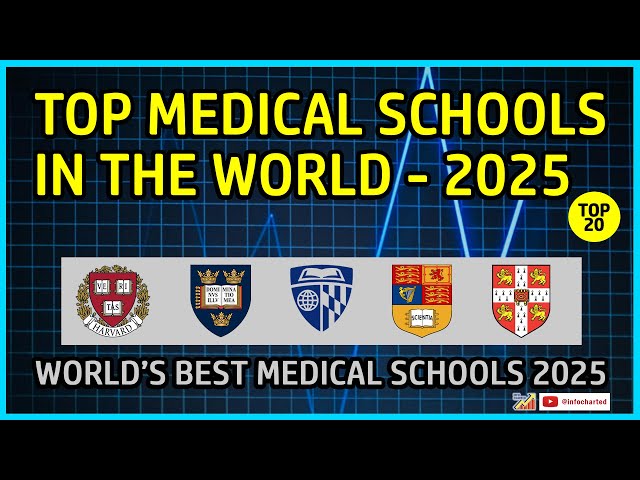Every year, thousands of aspiring doctors compete to enter the best medical schools in the United States. But what truly sets these institutions apart? Is it the world-class research, clinical exposure, faculty expertise, or post-graduation success rates?
In this detailed 2025 guide, we highlight the top medical schools in the U.S., breaking down their admission requirements, ranking criteria, MCAT and GPA expectations, and career prospects. Whether you’re a U.S. resident or an international student aiming to study medicine in the States, this article is your comprehensive resource to navigate your academic choices.
What Defines a Top U.S. Medical School?
A top-tier medical school is typically measured by:
-
U.S. News & World Report rankings
-
NIH research funding
-
Residency match rates
-
Curriculum innovation and clinical partnerships
-
Student satisfaction and diversity
-
Faculty-to-student ratio
Other influencing factors include tuition cost, geographic location, specialty training access, and alumni success.
Common Admission Requirements Across Elite Medical Schools
While individual requirements vary slightly, the following are common across top medical institutions:
Academic Credentials
-
Bachelor’s Degree: Usually in a science-related field
-
MCAT Score: 515–522 for highly competitive applicants
-
Undergraduate GPA: 3.7–3.95
Prerequisite Courses
-
General Biology with lab (2 semesters)
-
General and Organic Chemistry with lab
-
Biochemistry
-
General Physics with lab
-
Mathematics or Statistics
-
English or Composition
Application Materials
-
Personal Statement
-
Letters of Recommendation (2–5, including professors and professionals)
-
AMCAS Primary Application
-
Secondary Essays (school-specific)
-
Interviews (MMI or panel)
Top 15 Medical Schools in the U.S. (2025 Edition)
Here’s a curated list of the top U.S. medical schools for 2025 based on reputation, research funding, innovation, and career outcomes.
| Medical School | Location | Avg. MCAT | Avg. GPA | Notable Features |
|---|---|---|---|---|
| Harvard Medical School | Boston, MA | 520 | 3.92 | World-class research & teaching |
| Stanford University | Stanford, CA | 519 | 3.89 | Tech integration in medicine |
| Johns Hopkins | Baltimore, MD | 521 | 3.93 | Hospital system and research |
| University of Pennsylvania (Perelman) | Philadelphia, PA | 520 | 3.91 | Ivy League training |
| Columbia Vagelos College of Physicians | New York, NY | 521 | 3.9 | Tuition-free program options |
| University of California, San Francisco (UCSF) | San Francisco, CA | 518 | 3.88 | Leading in public health |
| Mayo Clinic Alix School of Medicine | Rochester, MN | 520 | 3.92 | Tuition support, small class |
| Washington University in St. Louis | St. Louis, MO | 521 | 3.9 | Generous scholarships |
| Duke University School of Medicine | Durham, NC | 519 | 3.88 | Accelerated curriculum |
| University of Michigan | Ann Arbor, MI | 517 | 3.87 | Primary care & research |
| Yale School of Medicine | New Haven, CT | 520 | 3.9 | No grades in pre-clinical years |
| Vanderbilt University | Nashville, TN | 519 | 3.89 | Student-focused learning |
| Northwestern (Feinberg) | Chicago, IL | 519 | 3.88 | Integrated clerkship model |
| NYU Grossman School of Medicine | New York, NY | 522 | 3.93 | Full tuition coverage |
| University of Chicago (Pritzker) | Chicago, IL | 520 | 3.9 | Strong academic community |
Competitive Stats: MCAT, GPA, and Prerequisites
MCAT:
Most top schools require at least a 515, with elite programs often accepting 520+ for the incoming class.
GPA:
The average GPA is 3.85–3.95, especially among science majors.
Coursework Requirements:
Many schools now also require or prefer Biochemistry, Genetics, and Behavioral Sciences in addition to standard pre-med subjects.
Clinical Training and Research Facilities
Top U.S. medical schools provide unparalleled access to clinical and research experiences:
-
Harvard is linked to Massachusetts General, Brigham and Women’s, and Boston Children’s.
-
Johns Hopkins offers intensive clinical rotations in a world-famous hospital system.
-
UCSF leads in public health and global medicine.
Research opportunities start as early as the first year, often with NIH-funded projects, global health fieldwork, or translational science labs.
Career Outcomes and Residency Placement
Medical schools often publish their residency match lists, showcasing where their students go. At top schools, most graduates match into:
-
Top 10 hospital systems
-
Competitive specialties (Dermatology, Orthopedic Surgery, Radiology)
-
Dual-degree tracks (MD/PhD, MD/MPH, MD/MBA)
The average match rate for elite med schools is around 97%–100%, often into the student’s first or second choice.
Tips to Stand Out in Competitive Applications
To successfully apply to these highly selective schools:
-
Score High on the MCAT
Aim for 515+ and consider retaking if under 510. -
Demonstrate Research Experience
Join lab work early and co-author publications if possible. -
Engage in Clinical Shadowing
Include both inpatient and outpatient experiences. -
Volunteer in Underserved Communities
Reflect this in your personal statement. -
Prepare for Interviews
Practice MMI and traditional formats.
Frequently Asked Questions (FAQs)
1. How many schools should I apply to?
Apply to 15–20 schools, balancing reach, match, and safety programs.
2. Is research mandatory for top medical schools?
Highly recommended. Almost all admitted students have at least one research experience.
3. Can I get into a top med school with a low GPA?
It’s rare, but strong MCAT, stellar experiences, and upward academic trends can help.
4. Do top medical schools accept international students?
Yes, but usually only a few seats per class, and some require proof of full funding.
5. What is the best time to apply?
Apply early in the cycle—ideally by June or early July—for maximum interview consideration.
Final Thoughts
Choosing from the top medical schools in the U.S. for 2025 means considering more than just rankings. From curriculum design to clinical partnerships and residency outcomes, each school has its own strengths. Tailor your application to each institution’s values and demonstrate academic excellence, compassion, and a clear commitment to medicine.
By understanding what these elite programs expect, you can craft a competitive, authentic application that gets noticed.


